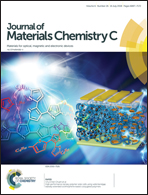Structural design of multilayer thermally conductive nanofibrillated cellulose hybrid film with electrically insulating and antistatic properties†
Abstract
With the development of miniaturized and highly integrated of microelectronic products, it has become particularly important to fabricate a thermally conductive, electrically insulating and environment-friendly composite as a thermal interface material (TIM) for heat dissipation. Here, we designed the structure of a multilayer thermally conductive hybrid film based on nanofibrillated cellulose and fillers (graphene and boron nitride) using the vacuum-assisted layer-by-layer (VA-LBL) self-assembly technique. Fully unifying the advantages of the thermally conductive three-layer electrically insulating film and an antistatic film, the ordered five-layer thermally conductive film (7.04 W m−1 K−1 with 8 wt% fillers) exhibits a comprehensive performance with electrically insulating and antistatic properties, which simultaneously has an excellent tensile strength (172 MPa). Therefore, it could be applied as a TIM for various thermal management applications with diverse requirements in a safe and environmentally friendly manner.



 Please wait while we load your content...
Please wait while we load your content...